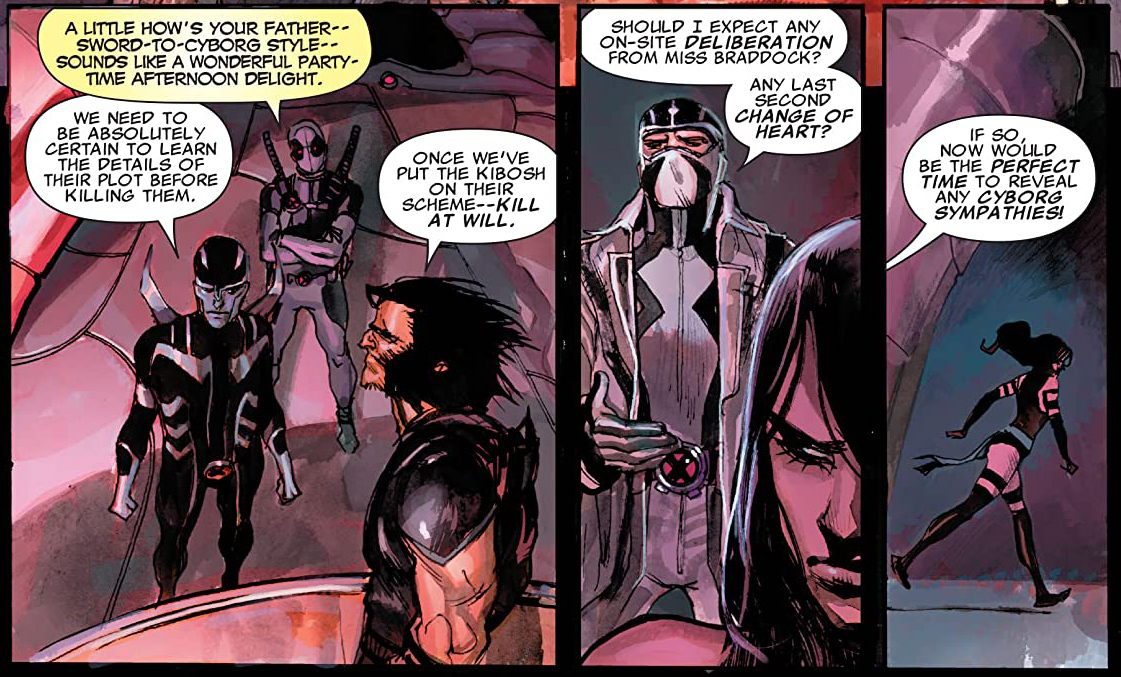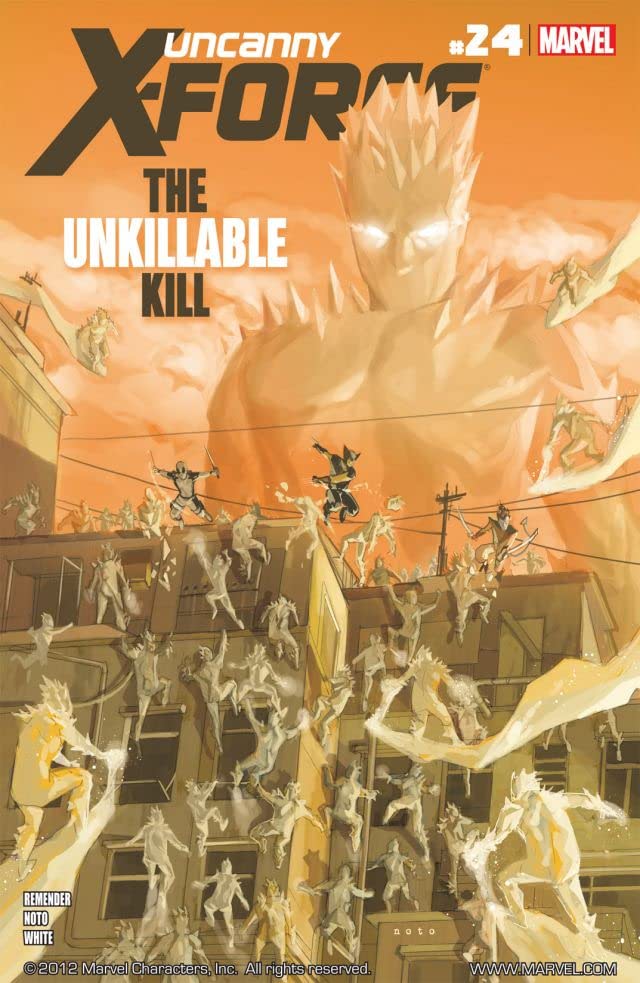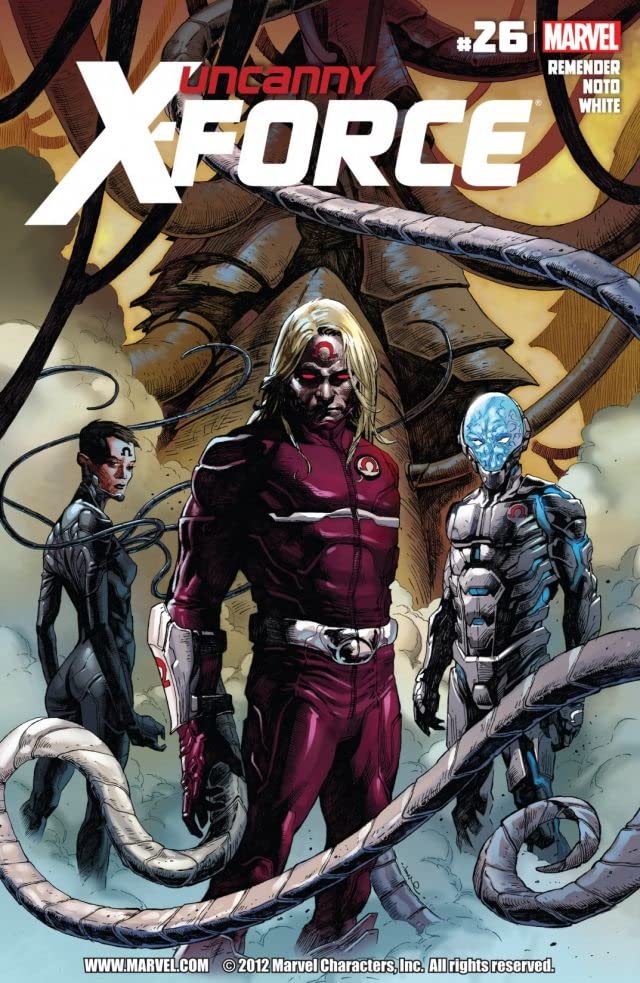Best Shots review: Rick Remender's Uncanny X-Force "an aesthetically stunning, intelligently written collision course of the relativity of good and evil"
Best Shots' Vanessa Gabriel takes a look at the entire run of Rick Remender's UNCANNY X-FORCE, calling it 'One for the Record Books.'

Uncanny X-Force has been a wild ride from the beginning. Curiosity sparked by Esad Ribic's seductive cover art led me to pick up Uncanny X-Force #1. The issue turned out to be a fast-moving art powerhouse and a character goldmine - a sign of things to come in Remender's 37-issue run.
Written by Rick Remender
Art by Jerome Opeña, Dean White, Esad Ribic, John Lucas, Matthew Wilson, Rafael Albuquerque, Billy Tan, Rich Elson, Paul Mounts, Mark Brooks, Andrew Currie, Scott Eaton, Andrew Hennessy, Jose Villarubia, Chris Sotomayor, Robbi Rodriguez, James Campbell, Greg Tocchini, Mike McKone, Julian Tedesco, Justin Ponsor, David Williams, Frank Martin Jr., Rachelle Rosenberg and Phil Noto
Lettering by Cory Petit
Published by Marvel Comics
Beautiful art, powerful characterization, and dichotomous themes are key elements to what make Uncanny X-Force such a solid comic book. But the real magic is in the impeccable pacing Remender employs throughout the entire series. From battling the Horsemen of Apocalypse to Wolverine's pain of failing as a father or Betsy cowering in a corner with a fragmented psyche to Wolverine viciously stabbing Creed for the umpteenth time; Remender moves from the action and violence to the motives of the characters like breathing. It is a brilliant balancing act.
The stakes are extremely high in Uncanny X-Force. It is always a matter of life or death, kill or be killed. Whoever you are rooting for may or may not be wearing a white hat. But when your mission is assassination then who really is? Remender's ever-engaging balancing act shows just how fluid the answer to that question is. "Will there always be bad people trying to kill me?," a young but not-quite-indoctrinated Apocalypse asks. This young boy is being bred by Clan Akkaba to bring humanity on this Earth to extinction, but it is Wolverine and his band of merry executioners that are perceived as "bad" by the boy. This is the first of many instances where the relativity of ethics is played like a drum by Remender.

The first page of the first issue is filled with the deep blue and brilliant greens painted by Dean White onto Jerome Opeña's gorgeous art. Opeña's signature is in his precise detail and striking perspectives. White's enchanting colors unequivocally define the book’s visual tone. Every page these two artists create - sometimes dark, sometimes gruesome, sometimes intricate - is a thing of beauty. The symbiosis of Opeña and White sets the aesthetic bar very high.
The four-issue, quick-and-dirty opening arc 'The Apocalypse Solution' is an exercise in instant gratification, with illustrations beyond pretty and a story that climaxes so fast you barely have time to meditate on the ethical quid pro quo. Archangel has been tracking the suspected location of Apocalypse. He employs those closest to him to join him in this task. Remender invokes a rapid-fire introduction to the team – Wolverine, Psylocke, Fantomex, Deadpool, and Archangel as they square off with the Final Horsemen of Apocalypse on the surface of the moon. As X-Force makes their way past the Horsemen, they find Apocalypse has been reincarnated as a child. And as quickly as X-Force banded together for the greater good, this black ops mission becomes the defining moment of the entire series. Fantomex's actions in the face of opposition from his entire team will tear them apart from within and propel Remender’s overarching theme of ethical relativism through the next 36 issues.
Cyborg mutant mash-ups come raining down from the future in hot pursuit of Fantomex and The World. In their future time-line, because of X-Force's Apocalypse solution and its chain of causality - mutantkind is destined to become judge, jury, and executioner. The cyborgs were created to avert this future of standardized X-Force-style preventative retribution. It is here that Remender starts playing with the infinite regress of 'killing a killer' for what might happen.

With the consequences of Fantomex's actions immediately rolling in in the second arc, 'Deathlok Nation,' deep remorse reverberates through the team. Deadpool has the kind of guilt that prompted him to call a meeting of the entire team so he can cope out loud. In this meeting, Wolverine aggressively rationalizes their choice and projects the anger at himself out onto his team. As they confront this together, here is where Remender draws you in. Here is where we see that they are human. The ethics of their actions melt away into how they each carry the burden within themselves. These are not evil people.
Get the best comic news, insights, opinions, analysis and more!
Cover artist extraordinaire Esad Ribic takes on interior art duties for this arc. His sequential art is clean and detailed. He creates phenomenal action sequences as a cyborg Hawkeye, Spider-Man, and Captain America are in hot pursuit of Fantomex over snow-covered mountains. Paired with Matthew Wilson on color duties, the two make for a nice consistency of high-quality illustration following Opeña and White.
The cyborg known as Deathlok is an anomaly that attempts to save Fantomex, and in doing so becomes a part of the team. The character reads as an examination of ethics in evolution. While the flesh part of Deathlok is a merciless killer, the cyborg artificial intelligence within him evolves to discover the inherent evil of enslavement. To be one of the cyborgs is to be enslaved as they are part of a collective consciousness. Deathlok's affinity for free will keeps the kinder AI consciousness at the forefront, but the evil part of his brain still exists. The character moves between the two sides as is necessary punctuating the notion of free will as well as being a poster child of Utilitarianism. Deathlok actively chooses to be 'good' or 'evil' as the missions call for it.
With this in mind, Remender segues into 'The Dark Angel Saga' with a few one-shot stories, each worthy of mention. He expands upon Psylocke, Wolverine, and Archangel respectively, adding depth to already well-defined characters and to the overall story.

Uncanny X-Force #5.1 takes an intense look at Psylocke. It is, at times, hard to read, but I couldn't look away. This mission pits the team against Lady Deathstrike and the Reavers, placing the Reavers in the sights of Psylocke. The story centers on her rage at what was done to her by the Reavers. They are the reason she is not in her original body. She delights at the opportunity for revenge on this mission. Again, Remender demonstrates the function of X-Force, while showing just how wrong it all is. Rafael Albuquerque illustrates this one issue, and his work is superb. He conveys the tone of grit and gloom with dynamic action and gruesome perspectives. His work makes 5.1 one of the darkest issues in the bunch.
Uncanny X-Force #8, aptly titled 'Unintended Consequences,' sees the art duties baton passed to Billy Tan and the return of colorist, Dean White. A perfectly paced issue that pits Psylocke against the Shadow King in a telepathic battle. A battle not limited by gravity or reality gave Tan and White the opportunity to be beautifully creative, and render some of the most memorable panels in the Uncanny X-Force run. There is one in particular of Psylocke as Lady Mandarin, poised for battle, which is drawn exquisitely and colored with bright magenta, purple and blue. It is in this battle that we see the return of the Dark Angel.
Remender takes a beat in issue #9, an issue between missions. 'High Art' is primarily a visual story that is low on dialogue. Magneto surprises X-Force (and the reader) with a visit. This issue is Magneto’s story. Tan is still on art duties, and with White's painting, he really shines here. The panel layout reads like sequential movie screens, wide and four to a page. The simplicity serves Remender's intelligently measured pacing. The facial expressiveness, strong body language, and unique visual perspectives make the scant dialogue still very telling. Warren hides his Archangel influence, Wolverine reiterates the Utilitarian mantra of their black ops outfit. The subtle character reveals that unfold are a perfect build-up to 'The Dark Angel Saga.'
Uncanny X-Force #10 reveals 'The Killer Within Warren,' and the team's next mission is to save Warren from Archangel. This is a necessary moment to the story because it is revealed that Archangel takes full control of Warren's psyche. We need that information to move forward, but as a whole, this is not a great issue. The story moments feel obligatory and it is one of very few where the art suffers. Tan takes assists from Rich Elson, and the consistency and detail are lacking. We also see colors from Paul Mounts who is not Dean White, adding another notch in the inconsistency belt. The art is immediately remedied by Mark Brooks as we begin the next arc. He joins the book as penciller and White returns as X-Force leaves this dimension to go to the Age of Apocalypse, Earth-295.

Heralded by creators and fans alike as one of the best stories of the year, 'The Dark Angel Saga' marks the true climax of Rick Remender's Uncanny X-Force. It is an aesthetically stunning, intelligently written collision course of the relativity of good and evil. Robbi Rodriquez beautifully illustrates the in-between issue of the fallout from 'The Dark Angel Saga' where the consequences of X-Force finally seep into the world of X-Men. Evan, also known as Genesis, is genetically identical to En Sabah Nur. He is byproduct of everything X-Force has done up to this point, a byproduct created by Fantomex unleashed to stop the Dark Angel, and now he is being sent to the Jean Grey School for Higher Learning. Fantomex raised him virtually in the World by a loving family with 'good' values. Nature versus nurture rears its paradoxical head, again. When Wolverine interrogates Fantomex as to why he would do such a thing, another theme becomes clear, too. Redemption.
As Fantomex, Psylocke, Deadpool, and Wolverine travel to the Age of Apocalypse, their worst fears are affirmed as they come face to face with what will happen to their Earth if Apocalypse were to rise to power. In desperate search of the Life Seed that could return their Warren from the grips of Archangel, the team encounters alternate versions of friends, lovers, and foes that have died in their own world. In this dimension, their Wolverine is evil, and so the reaction to X-Force's Wolverine is severe. On the same note, Creed is not evil in the Age of Apocalypse. Genetically the same materials comprised these mutants, yet given their environment - they are very different beings. It begs the question: if evolution is so superior in its natural selection, how is it that nurture weighs so heavily?
With the Life Seed in hand intent on saving Warren, X-Force returns to their dimension to find that Archangel has been freed by the Clan Akkaba. Everything that the team has worked to prevent comes undone as Archangel ascends as the incarnate of Apocalypse, complete with a powerful cult following. Archangel has set in motion the events to bring about the extinction of all life on Earth. Tabula Rasa. From this blank slate, evolution will reign supreme. All X-Force has to do to stop it is plant the Life Seed into Archangel, but it will kill him.
Remender employs every bit of action and emotion that has been built to conclude 'The Dark Angel Saga' in a resolution that would make any grown comic book-loving person cry. X-Force does what X-Force has to do, kill to survive. This chapter of Uncanny X-Force is made even sweeter by the return of Jerome Opeña. He illustrates every bit of violence, suffering, and salvation perfectly.

Revealed as the driving force of causality, Fantomex has been judged for murdering the boy Apocalypse, and Captain Britain and the omniverse watchers of Otherworld intend to punish him for it. Fantomex and Psylocke have sneaked away to Otherworld, and AoA Nightcrawler, Wolverine, and Deadpool follow them to land themselves in the middle of a war. As the three of them are on the verge of becoming casualties in this war raging in Otherworld, Fantomex's judicial fate is in Psylocke's hands.
The emotional storm of the past story arc is punctuated viscerally by the events in Otherworld. It is a particularly cavalier story, the momentum driven by action and violence and only supported by sharp character dialogue. Again, we see how Remender moves through different methods of pacing. The physical chaos in the battle scenes of Otherworld serves as a reprieve from the psychological turmoil of The Dark Angel Saga.
Greg Tocchini's art aptly displays the chaos and intensity happening in Otherworld, but his sketchy, abstract stylization leaves a lot to be desired when it comes to finer detail. However, some interesting perspectives make up for the lack of detail. If you haven't sensed a theme yet, Dean White's colors are a touchstone, and in this instance, a saving grace. Cory Petit, who lettered all but one issue of Remender's run, really shines in this arc. His precise, angular lettering for the Goat Demon added just the right eerie vibe. Collectively, the art works.
After twenty-three issues, Remender's train doesn't lose any steam, and leads us full speed ahead into 'The Final Execution.' In another nod to Remender's penchant for pacing, issue #24 is an in-between issue; AoA Nightcrawler gets his chance at revenge with this Earth's Bobby Drake and we learn what Psylocke gave up in Otherworld to save Fantomex. Drawn to emotional perfection in his signature crispness, Phil Noto joins the ranks of the top-notch artists on this title.

The burden of their missions has left our team battered and broken, especially Psylocke and Fantomex. In spite of Fantomex's detrimental manipulations, he's fallen in love with Betsy. But Betsy is too far gone, traumatized to numbness, to return any such emotion. The fearless leader, Wolverine, is left with AoA Nightcrawler whose sole desire is revenge and a Wade that has a new, pretty face and no healing factor. Things are falling apart, leaving a feeling of desolation and failure. Even though their missions have been a 'success' up to this point, their asses are writing checks that their souls can't cash.
Is killing in the name of good ... really good? When and why is killing the answer? Who decides who is worthy of life and who is sentenced to death? Isn't it just two sides of the same coin? All of these questions permeate Remender's Uncanny X-Force, and he brings it all to a satisfying close in Final Execution.
With the X-Force team shattered, the new Brotherhood of Evil Mutants moves in to exact their form of justice upon X-Force. Said justice sends the team 30 years in the future to witness everything they feared had come to be and what an X-Force of the future looks like. It's a place where Betsy Braddock is leader, and they kill preemptively to prevent crime. It is here that Remender gives one of the most provocative and ethically relative moments of the series when Betsy has a conversation with her future self.
Mike McKone fills in for an issue and his art is good. From backgrounds to facial close-ups, I was impressed by the crispness of it all. McKone's striking clarity combined with White's always vibrant colorwork served as a nice fill-in for Phil Noto. But I was happy when Noto returned, but he is only around for two issues. Then Julian Totino Tedesco and Dave Williams fill in on art duties for a few issues. While neither of them hurt the aesthetic of the book, they don't do anything in particular to raise it. Tedesco has a few really striking panels, but much of the rest, Williams included, feels rushed. A natural consequence of a book that is shipping 18 issues a year. Thankfully, Noto returns to finish out the series.
Noto's work is, as always, crisp, clean, and easy on the eyes. Noto seems to take extra care with the final issues. I don't know where Frank Martin, Jr.'s colors end, and Dean White's begin. That is a good thing. I consider White to be the gold standard in coloring, and Martin's work here is just as good.

The new Brotherhood of Evil Mutants - Daken, Sabretooth, Shadow King, Mystique, Blob, and Skinless Man - is intent on bringing out the evil they believe exists inherently in Evan, the clone of En Sabah Nur. Once they get Evan in their grips, everyone has their own agenda, and inflicting suffering is the modus operandi. Daken is particularly deplorable, but the most captivating moments are with Mystique. She is subtle and demure with her evil, and her calm demeanor almost makes you a sympathizer to her cause. Maybe it is just how beautifully Phil Noto draws her. Best. Returned from the future, X-Force is intent on stopping the Brotherhood from corrupting Evan.
The character exposition of the Brotherhood of Evil Mutants creates a provocative juxtaposition with the members of X-Force because their respective motivations aren't that different. In a final push of utilitarianism versus the Kantian ethics of superheroes, Remender illustrates the irony and hypocrisy that is the X-Force. It is an infinite regress of murdering murderers, and the ethical dilemma of X-Force's existence is unavoidable. Isn't the Brotherhood operating under the same ethics as X-Force? Is the way X-Force kills any less cruel? Remender paints the ultimate shade of grey that throws the identity of this story's hero up in the air.
Alpha and Omega. Life and Death. Genesis and Apocalypse. Good and Evil. Nature and Nurture. If we are truly born 'Tabula Rasa,' then our nature is how we are nurtured. If nurture is the true bottom line, then why bother with the superiority or inferiority of a species? The past is the greatest indicator of the future, but who you are now may not be who you become. In Uncanny X-Force #35, the final issue, Remender defines the hero of this story in one of comic books' most heartfelt moments. It's one for the record books, as is the entire series.
Vanessa Gabriel does marketing, communications, and design things by day and comic nerd things by night. She's written comic reviews for over a decade but has opined on the portrayal of Wonder Woman for much, much longer.



